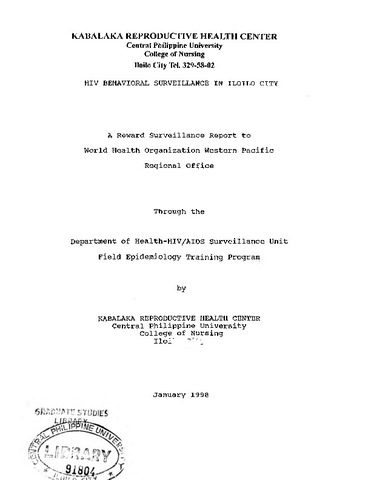HIV behavioral surveillance in Iloilo City
Аннотации
This behavioral surveillance was conducted to generate data on risk behaviors among female sex workers in Iloilo City. The output of this study will serve as basis for the prevention and control of STD and HIV/AIDS among the local government units, non-governmental organizations, and social scientists.
Specifically, the study has the following objectives:
1. identify the risk behavior patterns among the female sex workers.
2. provide timely and early warning data in identifying high risk behaviors and self-reported signs and symptoms of STDs.
3. identify risk-reduction practices, risk-avoidance behaviors for HIV/AIDS and health-seeking practices of female sex workers.
4. determine the knowledge, attitude, and exposure to STD and HIV/AIDS intervention.
5. determine if the consistency of condom use among the subjects is independent of their educational attainment.
6. determine if the signs and symptoms of STD among the subjects is independent of the number of their sex partners.
7. determine if the signs and symptoms of STD among the subjects is independent of their sex partners.
8. determine if the signs and symptoms of STD among the subjects is independent of their condom use in the last sexual intercourse.
9. determine if significant correlations would exist among the selected variables.
To answer these objectives, the study utilized an interview schedule devised by the DOH. The subjects of this investigation were the 240 randomly selected female sex workers— composed of 120 female registered sex workers interviewed from the different establishments (night clubs, massage parlors, and KTVs and Karaoke bars) and 120 female free-lance sex workers interviewed in places where they could usually be found to attract customers.
Frequencies, percentages, and ranks were used as descriptive statistics and the Kolmogorov-Smirnov test of independence, the Chi-square test for independence and the Pearson's r as inferential statistics.
Results of the surveillance showed that: (1 ) the RFSW had at least one sexual contact with their regular sex partner, while the FLFSW had at least one sexual contact with either their regular and non-regular sexual partners one week prior to the surveillance; (2) very few subjects use condom regularly; (3) majority did not use condom on their last sexual intercourse— more RFSW preferred not to use condom than the FLFSW; (4) when engaged with their non¬-regular sex partners, more RFSW used condom in their last sexual intercourse than FLFSW— a high percentage of condom use were claimed by the subjects exposed to their non¬-regular sex partners; (5) one out of four subjects experienced signs and symptoms of STD for the last six months— more RFSW were infected than the FLFSW; (6) majority received advise on STD/HIV/AIDS— more FLFSW received advise than the RFSW; (7) the Social Hygiene Clinic and the health worker were the most popular institution/person consulted by the subjects when they experienced discomfort caused by STD— family members were least consulted for advise on STD and HIV AIDS; (8) the subjects had "moderate knowledge" on STD and HIV/AIDS and were "not fully knowledgeable" on practices that can protect them from being infected with STD and HIV/AIDS; (9) the RFSW assessed themselves as having "no chance" of being infected with STD and HIV/AIDS, while the FLFSW indicated a "small chance"; (10) majority of the subjects were interviewed about STD and HIV/AIDS for the last six months; (11) the subjects were not significantly in the consistency of condom use grouped according to educational attainment. (12) the subjects were significantly independent in pain/burning sensations experienced when grouped according to condom use— those who "sometimes" use condom were more vulnerable to experiencing pain/burning sensations more than those who "always" and "never" use condom; (14) the subjects were significantly independent in terms of yellowish discharges in their genitalia when grouped according to number of sex partners— in favor of those with 1-3 sex partners and according to consistency of condom use in favor of those who "sometimes" use condom; and (15) knowledge of and attitude a b o u t STD and HIV/AIDS were positively and significantly correlated among the subjects and knowledge of and attitude toward HIV/AIDS were positively and significantly correlated with condom use.
Описание
Executive summary
Suggested Citation
Gumayan, M. V. F. , Abioda, N. D. , Catedral, M. B. & Leysa, G. C. (1998). HIV behavioral surveillance in Iloilo City (Research report). Jaro, Iloilo City: Kabalaka Reproductive Health Center, Central Philippines University.
Type
Technical ReportТематика
Keywords
Shelf Location
GSL 610.73072 K111
Physical Description
xiii, 48 leaves
Collections
- Research reports [8]
- Research reports [167]
The following license files are associated with this item:





